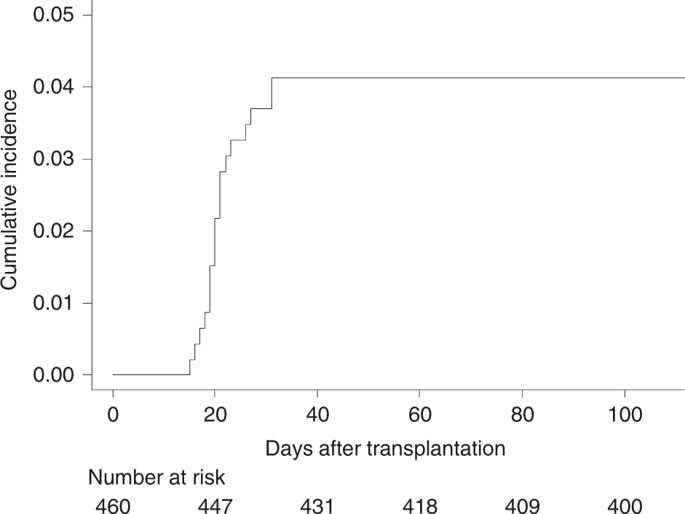当前位置:
X-MOL 学术
›
Bone Marrow Transpl.
›
论文详情
Our official English website, www.x-mol.net, welcomes your
feedback! (Note: you will need to create a separate account there.)
Clinical characteristics of human herpesvirus-6 myelitis after allogeneic hematopoietic stem cell transplantation and its favorable outcome by early intervention.
Bone Marrow Transplantation ( IF 4.5 ) Pub Date : 2019-11-21 , DOI: 10.1038/s41409-019-0755-2 Kohei Shiroshita 1 , Takehiko Mori 1 , Jun Kato 1 , Masatoshi Sakurai 1 , Yuya Koda 1 , Ryohei Abe 1 , Koichi Murakami 1 , Chieko Sumiya 1 , Shinya Fujita 1 , Kentaro Yamaguchi 1 , Rie Yamazaki 1 , Hitomi Nakayama 1 , Shigeaki Suzuki 2 , Jin Nakahara 2 , Shinichiro Okamoto 1
Bone Marrow Transplantation ( IF 4.5 ) Pub Date : 2019-11-21 , DOI: 10.1038/s41409-019-0755-2 Kohei Shiroshita 1 , Takehiko Mori 1 , Jun Kato 1 , Masatoshi Sakurai 1 , Yuya Koda 1 , Ryohei Abe 1 , Koichi Murakami 1 , Chieko Sumiya 1 , Shinya Fujita 1 , Kentaro Yamaguchi 1 , Rie Yamazaki 1 , Hitomi Nakayama 1 , Shigeaki Suzuki 2 , Jin Nakahara 2 , Shinichiro Okamoto 1
Affiliation

|
After allogeneic hematopoietic stem cell transplantation (HSCT), human herpesvirus-6 (HHV-6) can cause serious central nervous system (CNS) disorder and typically presents as encephalitis. Another manifestation of HHV-6 is myelitis, which has not been fully evaluated. In this study, we retrospectively analyzed 19 patients who developed HHV-6 myelitis after allogeneic HSCT. Median onset was 20 days after transplantation (range, 13-31), with a cumulative incidence of 4.1% at day 40 after transplantation. Median age at transplant was 50 years (range, 17-61). Median copy number of HHV-6 DNA was 3000 copies/ml in cerebrospinal fluid (CSF; range, 200-100,000). The most common symptoms were pruritus, pain of the extremities/back, and numbness. Three patients subsequently developed encephalitis in the clinical course of myelitis; their HHV-6 copy numbers in CSF had been higher than 10,000 copies/ml at the onset of myelitis. Antiviral agents were initiated shortly after onset in all patients, resulting in recovery. These results suggest that myelitis would be an important subtype of HHV-6-associated CNS disorders after allogeneic HSCT, whose prognosis could be favorable by an early intervention. Transplant physicians should recognize early posttransplant neurological symptoms such as pruritus, pain, or numbness as possible signs of HHV-6 myelitis, which could also progress to encephalitis.
中文翻译:

同种异体造血干细胞移植后人疱疹病毒-6型脊髓炎的临床特征及其早期干预的良好结果。
同种异体造血干细胞移植(HSCT)后,人疱疹病毒6(HHV-6)会引起严重的中枢神经系统(CNS)疾病,通常表现为脑炎。HHV-6的另一种表现是脊髓炎,尚未得到充分评估。在这项研究中,我们回顾性分析了异基因HSCT后发展为HHV-6脊髓炎的19例患者。中位发病时间为移植后20天(范围13-31),在移植后第40天累积发生率为4.1%。移植时的中位年龄为50岁(范围17-61)。HHV-6 DNA在脑脊髓液中的拷贝数中位数为3000拷贝/ ml(CSF;范围200-100,000)。最常见的症状是瘙痒,四肢/背部疼痛和麻木。三名患者随后在脊髓炎的临床过程中患上了脑炎。在脊髓炎发作时,它们在脑脊液中的HHV-6拷贝数已高于10,000拷贝/ ml。所有患者发病后不久就开始使用抗病毒药,从而使病情得以恢复。这些结果表明,在同种异体造血干细胞移植后,脊髓炎可能是与HHV-6相关的中枢神经系统疾病的重要亚型,早期干预可能有助于其预后。移植医师应将移植后早期的神经系统症状(例如瘙痒,疼痛或麻木)识别为HHV-6脊髓炎的可能迹象,这也可能发展为脑炎。早期干预可能会改善患者的预后。移植医师应将移植后早期的神经系统症状(例如瘙痒,疼痛或麻木)识别为HHV-6脊髓炎的可能迹象,这也可能发展为脑炎。早期干预可能会改善患者的预后。移植医师应将移植后早期的神经系统症状(例如瘙痒,疼痛或麻木)识别为HHV-6脊髓炎的可能迹象,这也可能发展为脑炎。
更新日期:2019-11-22
中文翻译:

同种异体造血干细胞移植后人疱疹病毒-6型脊髓炎的临床特征及其早期干预的良好结果。
同种异体造血干细胞移植(HSCT)后,人疱疹病毒6(HHV-6)会引起严重的中枢神经系统(CNS)疾病,通常表现为脑炎。HHV-6的另一种表现是脊髓炎,尚未得到充分评估。在这项研究中,我们回顾性分析了异基因HSCT后发展为HHV-6脊髓炎的19例患者。中位发病时间为移植后20天(范围13-31),在移植后第40天累积发生率为4.1%。移植时的中位年龄为50岁(范围17-61)。HHV-6 DNA在脑脊髓液中的拷贝数中位数为3000拷贝/ ml(CSF;范围200-100,000)。最常见的症状是瘙痒,四肢/背部疼痛和麻木。三名患者随后在脊髓炎的临床过程中患上了脑炎。在脊髓炎发作时,它们在脑脊液中的HHV-6拷贝数已高于10,000拷贝/ ml。所有患者发病后不久就开始使用抗病毒药,从而使病情得以恢复。这些结果表明,在同种异体造血干细胞移植后,脊髓炎可能是与HHV-6相关的中枢神经系统疾病的重要亚型,早期干预可能有助于其预后。移植医师应将移植后早期的神经系统症状(例如瘙痒,疼痛或麻木)识别为HHV-6脊髓炎的可能迹象,这也可能发展为脑炎。早期干预可能会改善患者的预后。移植医师应将移植后早期的神经系统症状(例如瘙痒,疼痛或麻木)识别为HHV-6脊髓炎的可能迹象,这也可能发展为脑炎。早期干预可能会改善患者的预后。移植医师应将移植后早期的神经系统症状(例如瘙痒,疼痛或麻木)识别为HHV-6脊髓炎的可能迹象,这也可能发展为脑炎。











































 京公网安备 11010802027423号
京公网安备 11010802027423号